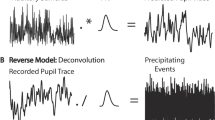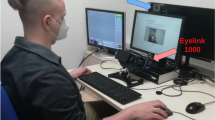Abstract
Shifting the direction of the line of sight in everyday life often involves rotations not only of the eyes and head but also of the trunk. Here, we investigated covariation patterns of eye-in-orbit, head-on-trunk and trunk-in-space angular horizontal displacements during whole-body rotations to targets of up to 180° eccentricity performed by standing healthy human subjects. The spatial covariation was quantified statistically across various behavioral task conditions (unpredictable, memory driven predictable, visual feedback) and constraints (accuracy) by principal components (PC) analysis. Overall, the combined movement was stereotyped such that the first two PCs accounted for essentially the whole data variance of combined gaze transfers up to about 400 ms, suggesting that the three mechanical degrees of freedom under consideration are reduced to two kinematic degrees of freedom. Moreover, quantification of segment velocity variability across repetitions showed that velocities of eye-in-space and head-in-space (i.e. ‘end-point’ velocity) were less variable than those of the elemental variables composing them. In contrast, three statistically significant PCs accounted for the covariation of the three segments during presumably vestibularly mediated nystagmic transfers, suggesting control by a separate driving circuit. We conclude that progression of the line of sight is initially stereotypic and fulfills criteria defining a motor synergy.





Similar content being viewed by others
References
Alexandrov A, Frolov A, Massion J (1998) Axial synergies during human upper trunk bending. Exp Brain Res 118:210–220
Anastasopoulos D, Ziavra N, Hollands M, Bronstein A (2009) Gaze displacement and inter-segmental coordination during large whole body voluntary rotations. Exp Brain Res 217:336–346
Baldissera F, Rota V, Esposti R (2008) Anticipatory postural adjustments in arm muscles associated with movements of the contralateral limb and their possible role in interlimb coordination. Exp Brain Res 185:63–74
Barnes G (1979) Vestibulo-ocular function during co-ordinated head and eye movements to acquire visual targets. J Physiol 287:127–147
Bernstein NA (1967) The co-ordination and regulation of movements. Pergamon Press, London
Bizzi E, Kallil RE, Tagliasco V (1971) Eye-head coordination in monkeys: evidence for centrally patterned organization. Science 173:452–454
Chun KS, Robinson DA (1978) A model of quick phase generation in the vestibuloocular reflex. Biol Cybernetics 28:209–221
Cooley WW, Lohnes PR (1971) Multivariate data analysis. Wiley, New York
Dichgans J, Bizzi E, Morasso P, Tagliasco V (1973) Mechanisms underlying recovery of eye-head coordination following bilateral labyrinthectomy in monkeys. Exp Brain Res 18:548–562
Freedman E (2008) Coordination of eyes and head during visual orienting. Exp Brain Res 190:369–387
Freedman E, Sparks D (1997) Eye-head coordination during head-unrestrained gaze shifts in rhesus monkeys. J Neurophysiol 77:2328–2348
Grantyn A, Berthoz A (1987) Reticulo-spinal neurons participating in the control of synergic eye and head movements during orienting in the cat. I Behavioral properties. Exp Brain Res 66:339–354
Grantyn A, Grantyn R (1982) Axonal patterns and sites of termination of cat superior colliculus neurons projecting in the tect-bulbo-spinal tract. Exp Brain Res 46:243–256
Guitton D, Volle M (1987) Gaze control in head free humans during orienting movements to targets within and beyond the oculomotor range. J Neurophysiol 58:427–459
Hassler R (1956) Die zentralen Apparate der Wendebebedungen. Archiv fuer Psychiatrie und Zeitschrift Neurologie 194:456–516
Land M (1992) Predictable eye-head coordination during driving. Nature 359:318–320
Land M (2004) The cordination of rotations of the eyes, head and trunk in saccadic turns produced in natural situations. Exp Brain Res 159:151–160
Latash M (2008) Synergy. Oxford University Press, New York
Laurutis V, Robinson D (1986) The vestibulo-ocular reflex during human saccadic eye movements. J Physiol 373:209–233
Mah CD, Hulliger M, Lee RG, O’Callaghan I (1994) Quantitative analysis of human movement synergies: constructive pattern analysis for gait. J Mot Bahav 26:83–102
McCluskey M, Cullen K (2007) Eye, head and body coordination during large gaze shifts in rhesus monkeys: movement kinematics and the influence of posture. J Neurophysiol 97:2976–2991
Morasso P, Bizzi E, Dichgans J (1973) Adjustment of saccadic characteristics during head movements. Exp Brain Res 16:492–500
Moschner C, Zangemeister WH (1993) Preview control of gaze saccades: efficacy of prediction modulates eye-head interaction during human gaze saccades. Neurol Res 15:417–432
Munro-Davies LE, Winter J, Aziz TZ, Stein JF (1999) The role of the pedunculopontine region in basal-ganglia mechanisms of akinesia. Exp Brain Res 129:511–517
Paré M, Guitton D (1998) Brainstem omnipause neurons and the control of combined eye-head gaze saccades in the alert cat. J Neurophysiol 79:3060–3076
Pelisson D, Prablanc C, Urquizar C (1988) Vestibuloocular reflex inhibition and gaze saccade control characteristics during eye-head orientation in humans. J Neurophysiol 59:997–1013
Rocchi L, Mancini M, Chiari L, Cappello A (2006) Dependence of anticipatory postural adjustments for step initiation on task movement features: a study based on dynamometric and accelerometric data. Conf Proc IEEE Eng Med Biol Soc 1:1489–1492
Roucoux A, Crommelinck M (1988) Control of head movement during visual orientation. In: Peterson BW, Richmond F (eds) Control of head movement. Oxford University Press, Oxford, pp 208–223
Shinoda Y, Sugiuchi Y, Izawa Y, Hata Y (2006) Long descending motor tract axons and their control of neck and axial muscles. Progr Brain Res 151:527–563
Siegel JM, Tomaszewski KS (1983) Behavioral organization of reticular formation: studies in the unrestrained cat. I. Cells related to axial, limb, eye and other movements. J Neurophysiol 50:696–716
Stefani A, Lozano AM, Peppe A, Stanzione P, Galati S, Tropepi D, Pierantozzi M, Brusa L, Scarnati E, Mazzone P (2007) Bilateral deep brain stimulation of the pedunculopontine and subthalamic nuclei in severe Parkinson’s disease. Brain 130:1596–1607
Takada M, Tokuno H, Ikai Y, Mizuno N (1994) Direct projections from entopeduncular nucleus to the lower brainstem in the rat. J Comp Neurol 342:409–429
Tehovnik EJ (1989) Head and body movements evoked electrically from the caudal superior colliculus of rats: pulse frequency effects. Behav Brain Res 34:71–78
Ting L, McKay JL (2007) Neuromechanics of muscle synergies for posture and movement. Curr Opin Neurobiol 17:622–628
Tomlinson R, Bahra P (1986) Combined eye-head gaze shifts in the primate II. Interactions between saccades and the vestibuloocular reflex. J Neurophysiol 56:1558–1570
Zangemeister WH, Stark L (1982a) Types of gaze movement: variable interactions of eye and head movements. Exp Neurol 77:563–577
Zangemeister WH, Stark L (1982b) Gaze latency: variable interactions of head and eye latency. Exp Neurol 75:389–406
Author information
Authors and Affiliations
Corresponding author
Electronic supplementary material
Below is the link to the electronic supplementary material.
Rights and permissions
About this article
Cite this article
Sklavos, S., Anastasopoulos, D. & Bronstein, A. Kinematic redundancy and variance of eye, head and trunk displacements during large horizontal gaze reorientations in standing humans. Exp Brain Res 202, 879–890 (2010). https://doi.org/10.1007/s00221-010-2192-8
Received:
Accepted:
Published:
Issue Date:
DOI: https://doi.org/10.1007/s00221-010-2192-8




